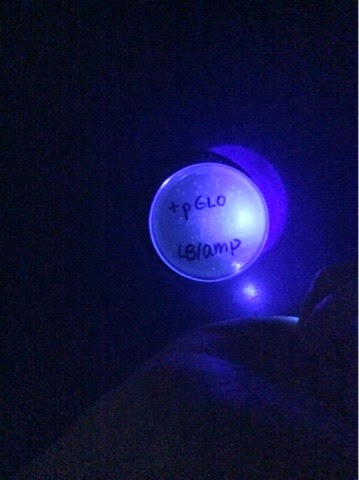Purpose: The purpose of this lab is to see if E. coli bacteria can successfully be transformed with a recombinant PGLO gene. If successful, the plates that were transformed will be antibiotic resistant as well as glow in the dark.
Procedures: First we took two micro-test tubes, label them either +pGLO or -pGLO, added 250 micro-liters of transformation solution (CaCl2) to both containers, and placed the test tubes on ice. The using two different sterile loops, we added bacteria (E. Coli) to the loop and added it to the transformation solution to both micro-test tubes. After that, we took on sterile loop full of pGLO plasmid DNA (this glows a turquoise color when under a UV light) and added it to the +pGLO micro-test tube only. Then for ten minutes we let the micro-test tubes sit on the ice for ten minutes.
After the ten minutes we put both the +pGLO and -pGLO micro-test tubes in a water bath that was at 42 degrees Celcuis for exactly 50 seconds, and immediately put the micro-test tubes back on the ice.
After waiting two more minutes, we added LB nutrient brother to both of the micro-test tubes. After mixing the solution we put Exactly 100 micro-liters of either +pGLO to the plates labeled LB /amp and LB/amp/ara and -pGLO to the plates LB and LB/amp. (The LB means that any bacteria will grow, LB/amp means that only plasmid can grow, and LB/amp/ara means that arabinose can be used by pGLO genes to make a fluorescent protein) by using a sterile loop we spread the bacteria around the agar plate and then let the plates sit in an incubator (37 degrees C) for a day.
This is Kat adding the pGLO DNA plasmid to the +pGLO micro-test tube. This was very difficult to do.
This is the micro-test tubes sitting in the cold water bath.
Data:
Here is a data table of what each of the plates looked like after sitting in the incubator.
Analysis: Some observations we made about the amount of bacteria growth were that less bacteria grew on the plates containing ampicillin, despite the fact that we used the bacteria that contained the pGlo plasmid. Tis leads us to believe that not all of the bacteria were transformed, because there was much less growth compared to the control group of bacteria on the LB plate. We knew we were able to transform some of the bacteria, because there was no growth on the Amp plate when the bacteria did not have the plasmid, and when the bacteria did contain plasmid, there was some growth. Also, we knew they were successfully transformed because the bacteria did not glow in the dark when they did not have the plasmid.
Conclusion: We were able to successfully transform baceria using the pGlo plasmid, to make it resistant to ampicillin and to glow under UV light.









No comments:
Post a Comment